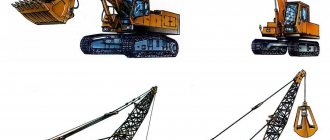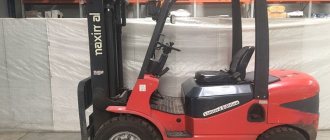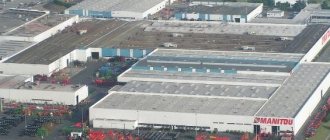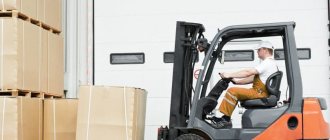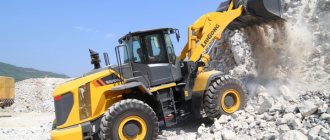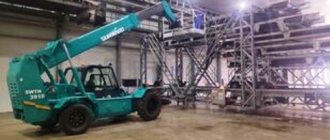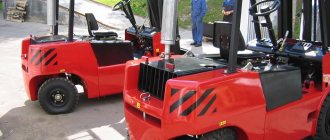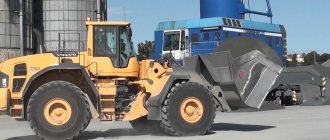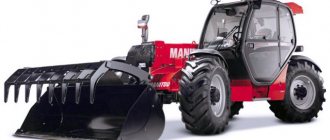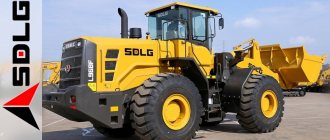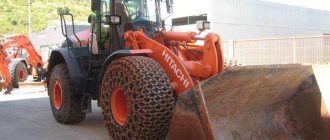What is a front loader: definition
The concept of a front loader and its perception are two different things. The name comes from the English language. It is derived from front - before and loader - loader. Strictly speaking, any type of loader with a working body located in front is a front-end loader, including telescopic, fork, and mini loaders.
However, the concept of a front loader is associated with four-wheeled equipment with a wide, full-width bucket. It may also be called a front loader or wheel loader. Although some machines have a tracked chassis, and some are mounted on the base of a wheeled tractor, the vast majority are made on their own chassis.
Due to its design and large selection of attachments, the front loader is widely used in various fields of activity from agriculture to the mining industry.
Electric forklifts
Electric forklifts, electric cars and electric stackers are not under the control of Gostekhnadzor, i.e. no rights to manage or obtain. But each driver must have an electric forklift driver’s license indicating the type of machine he is allowed to drive: a battery-powered forklift driver, an electric stacker driver, an electric reach truck driver, etc.
The history of front loaders
Front-end loaders are relatively new compared to cranes, excavators, bulldozers, scrapers, and graders. But, despite their youth, today they occupy second place in terms of market size for road construction machines after excavators.
The first front loaders were invented by farmers to make it easier to collect hay and manure. The old loader was a tractor with a bucket that was raised and lowered by winches.
A revolution in the production of these machines took place in the mid-twentieth century with the advent of hydraulics. It caused huge changes in the road construction industry. The hydraulic cylinder simplified the reciprocating movements of the working bodies and made it possible to turn using an articulated frame. This has already become a familiar all-wheel drive loader with a massive bucket, maneuverable and efficient.
General structure and technical characteristics
The main difference between loaders and other construction and road vehicles is the ratio of the load capacity and volume of the bucket to the weight of the equipment itself. This is achieved due to the optimally located center of gravity and weight distribution of the machine.
Therefore, when we talk about a front loader, we mean a classic machine with:
- four large wheels of the same diameter;
- rear engine;
- high-mounted cabin with good visibility;
- articulated frame, except for some compact and skid steer loaders;
- a large bucket located in front, which is sometimes replaced or forks, hooks, etc. are hung directly on it.
Front-end loaders are built on special wheeled chassis and have a single design. The articulated frame has a folding angle of the semi-frames in the range of 35-40°. The rear engine acts as a counterweight.
The power unit of most wheel loaders is diesel. Although more and more companies are modernizing them by installing hybrid, gas and electric engines. This is especially true for compact cars.
Typically, the use of a hydromechanical transmission with a 3- or 4-speed planetary gearbox, a drive axle with a differential lock system, a planetary wheel reduction gear, a rigid suspension of the front cargo axle and a balancer suspension of the rear axle. Sometimes, instead of a hydromechanical one, a hydrostatic continuously variable transmission is used.
The lifting boom has a Z-shaped or parallelogram design. The first is more effective when working with a front loader bucket, since it has greater breakout force. The second is preferable when changing working equipment frequently.
The ergonomics of the operator's workplace is no less important. The front loader cabin provides all-round visibility and is equipped with an adjustable seat, heating, ventilation, and noise absorption systems. The automated gear shifting and control system is designed for various operating modes selected by the operator depending on operating conditions.
The volume of a front loader bucket varies depending on the class of machine. For mini loaders it can be 0.5 cubic meters, while for mining wheeled vehicles it reaches up to 17 cubic meters.
How to determine the vehicle type code
In order to determine the vehicle type code, you will need the PTS and Appendix 5 to the Procedure approved by Order of the Federal Tax Service of Russia dated February 20, 2012 No. ММВ-7-11/99. It is from this that you should select the code corresponding to your vehicle. If the full characteristics of the vehicle are not clear to you from the passport, you will need the help of the organization’s technicians or mechanics to advise you on unclear points related to the characteristics of the vehicle.
| Dear visitors! The site offers standard solutions to problems, but each case is individual and has its own nuances. |
| If you want to find out how to solve your particular problem, call toll-free ext. 700 (consultation free) |
Having understood the characteristics of the vehicle and found out its design features, select the corresponding vehicle type code in Appendix No. 5.
Classification and application of front loaders
Load capacity, bucket volume, engine power and productivity are the main characteristics of a front loader. This means that cars are classified according to these criteria.
By load capacity
First of all, they are divided by load capacity and dimensions. Highlight:
- heavy mining loaders with a lifting capacity of over 10 tons;
- middle class - from 5 to 10 tons;
- compact – from 2 to 5 tons;
- mini loaders – with a lifting capacity of up to 2 tons.
By chassis type
There are three types of chassis on which front loaders are assembled. The most popular is the wheeled chassis with an articulated frame. This solution increases maneuverability and cross-country ability, since the wheels follow the trail.
The equipment is also produced on a rigid frame with pneumatic wheels. Car loaders are also capable of moving independently from one site to another, but have less maneuverability due to a larger turning radius.
Tires on wheeled models of any type can be pneumatic or solid. The former have good shock-absorbing properties. The latter are used where you can come into contact with sharp materials that can damage the tire.
Since solid rubber wheels are also susceptible to damage, there is a third type of front loader - tracked. They have good maneuverability on unstable soils, and are more effective in areas with uneven, sharp surfaces - in general, where there is a high probability of a tire puncture. They have a lower center of gravity, due to which the load capacity is higher. However, the main disadvantage of this design is the limitation on speed and movement on public roads.
Other classification
Most front loaders are universal. They can use both a front bucket and various interchangeable attachments - forks, lifting hooks, wheel holders, jaw grips.
But there are also special machines. For example, low underground load-and-haul machines (LDMs) also belong to the category of front-end loaders, but due to their design features they are used only in mines.
The use of quarry loaders in other jobs is difficult due to their large overall dimensions. Also, a front-end forklift is used exclusively for warehouse work.
Forklifts
Car loaders are distinguished by their versatility, maneuverability and fairly high speed of movement. The equipment runs on gasoline, gas, diesel fuel and can be used both in open areas and in well-ventilated areas.
There is no single, globally accepted classification of warehouse forklifts. The most detailed systematization was carried out by the American Industrial Transport Association ITA (Industrial Truck Association).
| Class | Types of warehouse forklifts | Purpose of special equipment | pros | Minuses |
| I | Electric (battery) with counterweight | Loading and unloading movement of palletized goods | No exhaust gases, silent operation | They need to be recharged (working time is wasted), and are practically not used outdoors. |
| II | Narrow aisle (VNA, reach trucks, side loaders) | Use in tight spaces, handling palletized loads; collection, stacking of goods | Saving useful warehouse space | Increased technical complexity, cost. |
| III | Self-propelled electric trolleys and stackers (with operator position or driven) | Operations with small quantities of goods. Moving cargo on pallets (electric trolleys), unloading from vans, warehousing, stacking | Simplicity and ease of use, affordable cost and efficiency | Low power and performance. |
| IV | Forklifts with solid tires | Handling cargo on pallets | Solid tires are ideal for driving on smooth surfaces. | Low ground clearance |
| V | Forklifts with pneumatic tires | Operations with pallets and 20, 40-foot containers | Versatility, quick movement inside warehouses and open areas | Restrictions apply for indoor use |
| VI | Tractors, conveyors | Moving goods in yards and warehouses | Versatility, ease of movement. | Unable to lift loads to heights |
| VII | Off-road forklifts (all-wheel drive) | Work on construction sites, logging | Increased cross-country ability, regardless of the quality of road surfaces, high power | Low maneuverability, significant dead weight |
Where are front loaders used?
With the exception of specialty models, the primary functions of front loaders are material handling, excavation, and site grading. Loaders are also used for road repair and rigging work, garbage collection, moving crushed stone, gravel, sand and other materials.
In addition, the loader can operate in bulldozer mode, transport bulk and lump loads in a bucket, and also tow trailers or other equipment over short distances.
